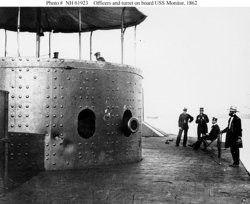USS Monitor
|
|

| |
| Career | Missing image USN-Jack.png USN Jack |
|---|---|
| Ordered: | 4 October 1861 |
| Laid down: | 1861 |
| Launched: | 30 January 1862 |
| Commissioned: | 25 February 1862 |
| Fate: | Lost at sea, 31 December 1862 |
| General Characteristics | |
| Displacement: | 987 tons |
| Length: | 172 ft (52 m) |
| Beam: | 41 ft 6 in (12.6 m) |
| Draft: | 10 ft 6 in (3.2 m) |
| Speed: | 8 knots (15 km/h) |
| Complement: | 59 officers and men |
| Armament: | 2 × 11 in (279 mm) Dahlgren smoothbores |
USS Monitor was an ironclad warship of the United States Navy. She is most famous for her participation in the first-ever naval battle between two ironclad warships, the Battle of Hampton Roads on March 9, 1862 during the American Civil War, in which Monitor fought the ironclad Virginia of the Confederate States Navy.
Before her, nearly all warships were made primarily of wood. After the Battle of Hampton Roads, the design of ships and the nature of naval warfare changed dramatically.
| Contents |
Design
[Image:Monitor_4.jpg|thumb|250px|USS Monitor, interior illustration. Image provided by Classroom Clipart (http://classroomclipart.com)]]Monitor was one of three ironclad warships ordered by the U.S. Navy, after the Galena and New Ironsides. Designed by the brilliant but choleric Swedish engineer John Ericsson, Monitor was described as a "cheesebox on a raft", consisting of a heavy, round iron turret on the deck housing two large Dahlgren cannon. The armored deck was barely above the waterline. Aside from a small, boxy pilothouse, a detachable smokestack and a few fittings, the bulk of the ship was below the waterline to prevent damage from cannon fire. Monitor's hull was constructed at the Continental Iron Works in the Greenpoint section of Brooklyn, New York, and the ship was launched there on January 30, 1862.
Monitor was innovative in construction technique as well as design. Parts were forged in nine different foundries and brought together to build the ship, with the entire process taking less than 120 days. In addition to the "cheesebox", its rotating turret, Monitor was also the first naval vessel to be fitted with Ericsson's marine screw. Ericsson anticipated some aspects of modern submarine design by placing all of Monitor's features except the turret and pilothouse underwater, making it the first semi-submersible ship. In contrast, Virginia was a conventional wooden vessel covered with iron plates and bearing fixed weapons.
Virginia attacked the Union blockading squadron in Hampton Roads, Virginia, on March 8, 1862, destroying USS Cumberland and USS Congress and forcing USS Minnesota aground before withdrawing. That night, Monitor, under command of Lt. John L. Worden, arrived under tow from Brooklyn. When Virginia returned the next day, March 9, 1862, to finish off Minnesota and the rest of the U.S. fleet, Monitor sailed forth to stop her. The ironclads fought for about four hours, neither one sinking or seriously damaging the other. Although the battle was essentially a draw, it was a tactical victory for Monitor. Virginia had failed in her mission to destroy the U.S. fleet and raise the blockade, while Monitor succeeded in defending the fleet. The ironclads never again fought each other.
The monitor warship type
USS Monitor became the prototype for the monitor warship type. Many more were built, including river monitors and deep-sea monitors, and they played key roles in Civil War battles on the Mississippi and James rivers. Some had two or even three turrets, and later monitors had improved seaworthiness.
Just three months after the famous Battle of Hampton Roads, the design was offered to Sweden, and in 1865 the first Swedish monitor was being built at Motala Warf in Norrk?g; she was named John Ericsson in Honor of the engineer. She was followed by 14 more monitors. One of them, S?, is still preserved at the marine museum in Gothenburg.
The last U.S. Navy monitor-class warship was struck from the Navy List in 1937.
Lost at sea
While the design of the USS Monitor was well-suited for river combat, her low free board and heavy turret made her highly unseaworthy in rough waters. This feature probably led to the early loss of the original Monitor, which foundered during a heavy storm. Swamped by high waves while under tow by the Rhode Island, she sank on December 31, 1862 in the Atlantic Ocean off Cape Hatteras, North Carolina.
The name Monitor was given to the troop carrier USS Monitor (LSV-5), commissioned late in World War II. She served primarily in the Pacific theater, and was later scrapped.
Rediscovery
In 1973, the wreck of the ironclad Monitor was located on the floor of the Atlantic Ocean about 26 miles southeast of Cape Hatteras, North Carolina. The wreck site was designated as the United States' first marine sanctuary. Monitor Sanctuary is the only one of the thirteen national marine sanctuaries created to protect a cultural resource, rather than a natural resource.
The site is now under the supervision of the U.S. National Oceanic and Atmospheric Administration. Many artifacts from Monitor, including her turret, propeller, anchor, engine and some personal effects of the crew, have been conserved and are on display at the Mariners' Museum of Newport News, Virginia.
External links
- Library of Virginia official website (http://www.lva.lib.va.us/)
- Virginia Historical Society official website (http://www.vahistorical.org/)
- Museum of the Confederacy in Richmond, VA official website (http://www.moc.org/)
- U.S. Naval History Center (http://www.history.navy.mil/photos/sh-usn/usnsh-m/monitr-u.htm)
- Monitor in the news – "Monitor turret raised from ocean" (http://www.HavenWorks.com/military/uss-monitor)
- Online exhibition about Monitor (http://www.pbs.org/wgbh/nova/monitor/)
- The Monitor Center (http://www.monitorcenter.org/) at the Mariners' Museum (http://www.mariner.org/), Newport News, Virginia
- Hampton Roads Visitor Guide (http://www.hamptonroadsvisitor.com)
- Hampton Roads Naval Museum (http://www.hrnm.navy.mil/)
- Civil War Naval History (http://www.multied.com/Navy/cwnavalhistory/)
- Fort Wool History (http://www.geocities.com/hrforts/Fort_Wool/history.htm)
- Roads to the Future – I-664 Monitor-Merrimac Memorial Bridge Tunnel (http://www.roadstothefuture.com/I664_VA_MMMBT.html)

